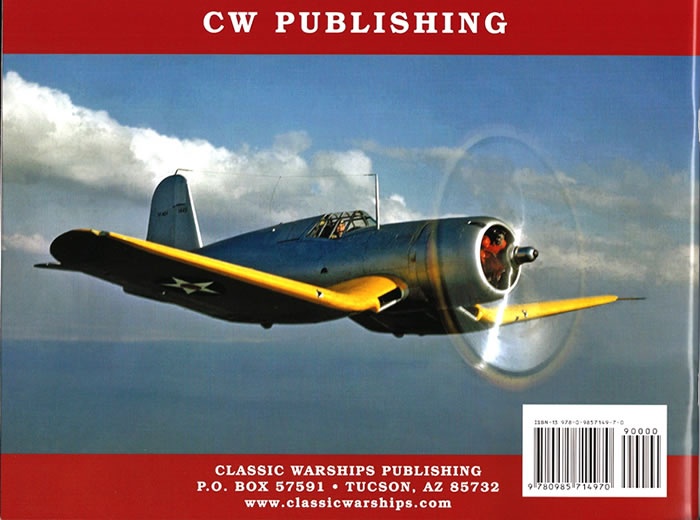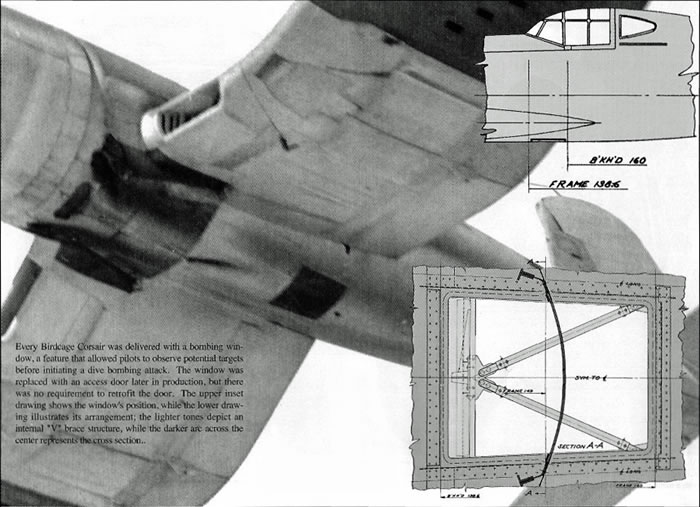Aircraft Pictorial #7
F4U-1 Corsair Vol.1
by Dana Bell

Classic Warships Publishing
| S u m m a r y |
Publisher, Title and ISBN: |
Aircraft Pictorial #7
F4U-1 Vol.1
by Dana Bell
Classic Warships Publishing
ISBN: 13-978-0-9857149-7-0 |
Media: |
Soft cover, Landscape A-4 Format, 72 pages plus covers. |
Price |
USD $17.95 on Amazon |
Review Type |
First Read |
Advantages |
A detailed painting guide and anatomical examination of the F4U-1 “Birdcage” Corsair: an excellent and invaluable resource . |
Disadvantages |
It makes one realize how much an extensive, in-depth study of the aircraft is needed. |
Conclusion |
An absolute necessity for anyone interested in the “Birdcage” Corsair, and for those modeling the aircraft. |
Reviewed by Steven Eisenman

P-40 Warhawk by Dana Bell is available online from Squadron.com
Once again, in the name of transparency and disclosure, my name does appear in the “Acknowledgements”. In no way does this affect my objectivity.
Dana begins this fine monograph by jumping the gun a bit. His first paragraph seeks to explain why the use of the -1A designation was not an official designation for the version that followed the F4U-1, F3A-1 and FG-1 “Birdcage” Corsair. But, in the end, for the purpose of this monograph and the one to follow, he makes use of the unofficial designations of “-1A” and, as he says, the popular description, “Birdcage” Corsair.
He then goes on to dispel the myth that the Corsair was a beast to land on a carrier, and thus relegated to land duties in its early years. The explanation makes perfect sense.

A quick review of early variations of the Birdcage Corsair is covered: the British Fleet Air Arm Mk. I, the photo-Corsair and Night Fighter. A few pages later we learn that final product of the three companies making the Birdcage Corsair, Vought, Brewster and Goodyear (the “VBG” group), were virtually indistinguishable from one another.
Construction and the issue of problematic radio masts are discussed next.
Then there is an excellent discussion of the camouflage and painting of the F4U-1 Birdcage Corsair. Again, as a result of his extensive research, Dana seeks to put aside misconceptions about some of the schemes in which the aircraft was painted. The interior colors and the use of the so-called ”salmon” primer are discussed. Some confusion could result from the first full paragraph on the top of page 5. A quick reading may lead one to think that the cockpit may have been salmon at one time. I believe that in the second sentence he is referring to internal structure other than the cockpit.
Of course, the heart of the monograph is the photos and captions. The photographs are well reproduced and there are a goodly number of color photos, including a couple of rare color photos of the aircraft in forward combat areas. The captions constitute the text of the monograph, and attempt to explain quite a bit. As with other volumes in the Aircraft Pictorial series, the aircraft is examined component section by section. Engine, landing gear, armament, cockpit, etc. are presented and explained and differences pointed out.
But a word of warning, go through the entire volume before you scratch your head at certain pages, wondering what the…
For example, on page 21 there are photos, diagrams and a discussion of the clear bombing window on the bottom of early Birdcage Corsairs. But there is no ordnance or bomb racks on the underside of the aircraft in the picture. Dive bombing with what? It is not until page 53 that the use of bomb racks is discussed. On page 54, the racks are used for another purpose, and I’d love to model that odd configuration.

On page 67 there is a printing error in the caption. The captions on page 66 to describe the “four-tone” were used again on page 67. Clearly, those Birdcage birds used in training on page 67 were re-painted in Glossy Sea Blue.
I am sure modelers will go over this monograph many time so they may incorporate the details noted into the models they are building. I presume this will include finding decals to number the ammunition boxes that were an integral part of the top of the wing. But, there are details that one does not want to be incorporated incorrectly. A couple of pictures show Birdcage Corsairs, with what appears to be eight machine guns. No Virginia, there were no eight gun Corsairs. A false eighth gun was created to deceive the enemy into thinking there was an up-gunned version. Painting or adding additional tape created the deception. But, it is not explained in the caption.
Speaking of tape, that white tape that is seen over panel seams in front of the cockpit, well it was not to keep gas fumes in so they would not get into the cockpit. Get the monograph to learn the real reason. It appears that another long held misconception is put to rest.
While there is no doubt this is an outstanding monograph on the Birdcage Corsair, I come away with a sense of frustration. Perhaps it is do to the monograph’s size limitations, and perhaps because I am aware of some of the items that were not included. Issues such as a further explanation of the Brwonscope, the internal structure of the outboard portion of the wing, especially around the gun bay and flaps, and why props were changed out for combat, among others, need more attention.
Originally, the project was to have both the Birdcage and -1A covered in a single 72-page volume. Thank the powers that be such idea was quickly tossed out. I look forward to Vol. 2 on the F4U-1A “Raised Cabin” Corsair.
I know that if wishes were horses then beggars would ride. But, what I would wish for is that Dana take these monographs on the Corsair and expand them into one tome that would be the go to resource on this most iconic aircraft of the war in the Pacific.
Regardless of my feelings, this is must have for anyone interested in or modeling the Corsair.
Thanks to Dana Bell and Classic Warships Publishing for the review copy.

Review Copyright © 2013 by Steven Eisenman
This Page Created on 16 July, 2013
Last updated
11 December, 2014
Back to HyperScale Main Page
Back to Reviews Page
|
